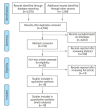Mothership versus Drip-and-Ship Model for Mechanical Thrombectomy in Acute Stroke: A Systematic Review and Meta-Analysis for Clinical and Radiological Outcomes
- PMID: 33053947
- PMCID: PMC7568974
- DOI: 10.5853/jos.2020.01767
Mothership versus Drip-and-Ship Model for Mechanical Thrombectomy in Acute Stroke: A Systematic Review and Meta-Analysis for Clinical and Radiological Outcomes
Abstract
Background and purpose: Substantial uncertainty exists on the benefit of organizational paradigms in stroke networks. Here we systematically reviewed and meta-analyzed data from studies comparing functional outcome between the mothership (MS) and the drip and ship (DS) models.
Methods: The meta-analysis protocol was registered international prospective register of systematic reviews (PROSPERO) and followed Preferred Reporting Items for Systematic Reviews and Meta-Analyses (PRISMA) guidelines. PubMed, EMBASE, and Cochrane Central databases were searched for randomized-controlled clinical trials (RCTs), retrospective and prospective studies comparing MS versus DS. Primary endpoints were functional independence at 90 days (modified Rankin Scale <3) and successful recanalization (Thrombolysis in Cerebral Infarction Scale [TICI] >2a); secondary endpoints were 3-month mortality and symptomatic intracranial haemorrhage (sICH). Odds ratios for endpoints were pooled using the random effects model and were compared between the two organizational models.
Results: Overall, 18 studies (n=7,017) were included in quantitative synthesis. MS paradigm was superior to DS model for functional independence (odds ratio, 1.34; 95% confidence interval, 1.16 to 1.55; I2=30%). Meta-regression analysis revealed association between onset-to-needle time and good functional outcome, with longer onset-to-needle time being detrimental. Similar rates of recanalization, sICH and mortality at 90 days were documented between MS and DS.
Conclusions: Patients with acute ischemic stroke eligible for reperfusion strategies might benefit more from MS paradigm as compared to DS. RCTs are needed to further refine best management taking into account logistics, facilities and resources.
Keywords: Drip and ship; Endovascular procedures; Mothership; Stroke; Thrombectomy.
Figures



References
-
- Goyal M, Menon BK, van Zwam WH, Dippel DW, Mitchell PJ, Demchuk AM, et al. Endovascular thrombectomy after largevessel ischaemic stroke: a meta-analysis of individual patient data from five randomised trials. Lancet. 2016;387:1723–1731. - PubMed
-
- Vidale S, Agostoni E. Endovascular treatment of ischemic stroke: an updated meta-analysis of efficacy and safety. Vasc Endovascular Surg. 2017;51:215–219. - PubMed
-
- Vidale S, Romoli M, Consoli D, Agostoni EC. Bridging versus direct mechanical thrombectomy in acute ischemic stroke: a subgroup pooled meta-analysis for time of intervention, eligibility, and study design. Cerebrovasc Dis. 2020;49:223–232. - PubMed
-
- Powers WJ, Rabinstein AA, Ackerson T, Adeoye OM, Bambakidis NC, Becker K, et al. 2018 Guidelines for the early management of patients with acute ischemic stroke: a guideline for healthcare professionals from the American Heart Association/American Stroke Association. Stroke. 2018;49:e46–e110. - PubMed
-
- Ismail M, Armoiry X, Tau N, Zhu F, Sadeh-Gonik U, Piotin M, et al. Mothership versus drip and ship for thrombectomy in patients who had an acute stroke: a systematic review and meta-analysis. J Neurointerv Surg. 2019;11:14–19. - PubMed
Publication types
LinkOut - more resources
Full Text Sources

